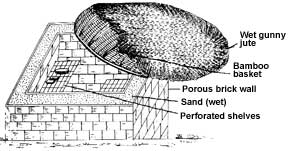Cool creation
 general estimations have showed that nearly 60 to 65 million tonnes of fruits and vegetables are produced in India. Out of this, 20 to 35 per cent is lost due to lack of proper storage facilities (Rural Technology, Vol 13, No 1). Now, a simple cold storage system for farmers has been devised by D S Bonde of Government Polytechnic, Yaotmal, near Nagpur (Madhya Pradesh). The system can be easily constructed and operated without any power supply and skilled labour. One can store the products in it for 10 to 15 days.
general estimations have showed that nearly 60 to 65 million tonnes of fruits and vegetables are produced in India. Out of this, 20 to 35 per cent is lost due to lack of proper storage facilities (Rural Technology, Vol 13, No 1). Now, a simple cold storage system for farmers has been devised by D S Bonde of Government Polytechnic, Yaotmal, near Nagpur (Madhya Pradesh). The system can be easily constructed and operated without any power supply and skilled labour. One can store the products in it for 10 to 15 days.
An open place has to be selected for its construction. On the lowermost flat surface two layers of bricks are placed with a gap of four to five inches between them without using lime or cement as a binding material. This cavity between the bricks is filled with riverbed sand. An insecticide powder needs to be sprayed below the bricks to avoid infection by fungi and insects.
Brick pillars can be erected every 10 feet for the construction of four walls. Care should be taken so that sand does not spill from the space between the bricks. A perforated rubber tube is also placed between the bricks. This tube is connected to an elevated water tank. Water is allowed to drip continuously at the rate of two to 2.5 litres per hour through the holes in the tube.
The roof is constructed using bamboo strips, grass and gunny bags. Grass is placed in between gunny bags and tightened to them using a binding wire. The roof should be rigid so that it does not lean down in the centre. Direct sunlight should be avoided on the roof. The water from the tube should be allowed to drip on all the bricks. Water has to be sprayed even on the roof so that it is absorbed uniformly by the gunny bags and bamboo grass. But excess water needs to be avoided as it can drip on fruits and vegetables placed inside the storage.
There is complete air circulation in the system from cavities between the bricks of the walls and the indoor temperature and humidity are maintained by the regular input of water. The fruits and vegetables are placed either in trays or in such a way that they are not in direct contact with the wet bricks.
